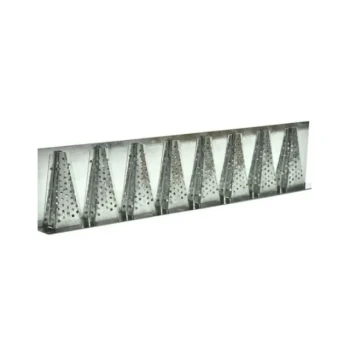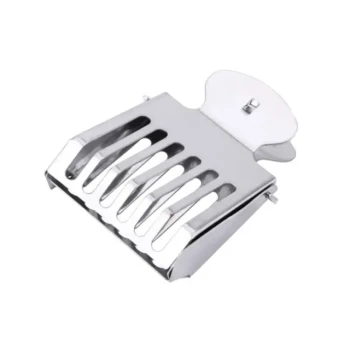In short, you keep ants out of a beehive by creating a physical barrier they cannot cross. The most effective methods involve elevating your hive on a stand and then applying a deterrent to the legs of that stand, such as creating a water-based moat or applying a slippery substance like petroleum jelly. This core strategy must be supported by keeping the surrounding area clear of any vegetation that could act as a bridge for ants to bypass your defenses.
The most reliable ant-prevention strategy is not a single trick, but a layered defense. It combines isolating the hive physically on a stand with diligent management of the surrounding environment to eliminate attractants and alternative access routes.

The Foundation: Isolate the Hive
Your first and most critical line of defense is the hive stand. Placing your hive directly on the ground invites pests of all kinds. By elevating it, you create a strategic chokepoint—the stand's legs—where you can focus your defensive efforts.
Method 1: The Water Moat
A moat is arguably the most effective physical barrier. Ants that attempt to cross it will drown, preventing them from ever reaching the hive.
Place each leg of your hive stand inside a larger, shallow container. Fill the container with soapy water. The soap is crucial as it breaks the water's surface tension, ensuring the ants sink immediately rather than potentially walking across the surface.
Method 2: Slippery Coatings
If a moat is not practical for your setup, applying a substance to the hive stand legs that ants cannot grip is a simple alternative.
Coat the legs of the stand with a thick layer of petroleum jelly (Vaseline). Ants are unable to traverse this slippery, sticky surface. This method is simple and effective but requires periodic inspection and reapplication.
Manage the Apiary Environment
A perfect barrier on your hive stand is useless if ants can simply bypass it. Maintaining the area around your hive is a non-negotiable part of your strategy.
Eliminate "Bridges"
Ants are resourceful climbers. Any blade of grass, weed, or overhanging branch that touches the hive or its stand becomes a bridge for them to cross.
Routinely trim all vegetation around and under the hive. Ensure there is a clear space of several inches between any plant life and the hive itself.
Remove Attractants
Ants are drawn to the hive by the promise of food, specifically honey, syrup, and bee larvae. Spills and debris act as a powerful lure.
Keep your apiary clean. Promptly clean up any spilled honey or sugar syrup. Remove any discarded pieces of burr comb, which often contain honey, from the ground near your hives.
Maintain Hive Integrity
A strong, well-sealed hive is easier to defend. Cracks and holes in your hive bodies can offer unprotected entry points for ants and other pests.
Periodically inspect your woodenware for any signs of decay, cracks, or gaps. Seal these openings to ensure the bees' only entrance is the one they can properly guard.
Understanding the Trade-offs
No solution is entirely "set and forget." Being aware of the limitations and maintenance requirements of each method is key to its long-term success.
Moat Maintenance
Water moats evaporate, especially in hot, dry climates. They must be refilled regularly. They can also collect leaves, dirt, and dead bees, which can form a new bridge for ants to cross. Keep them clean.
Reapplying Coatings
Petroleum jelly and other slippery barriers will become less effective over time. They collect dust, dirt, and dead ants, creating a surface that new ants can cross. You must clean and reapply the coating periodically.
Addressing the Source
If you have a severe, persistent ant problem, your yard may have one or more large ant mounds. While hive-level defenses are your priority, you may need to treat the source mound. If you do, use natural insecticides and apply them far away from the hive to avoid any risk to your bees.
Making the Right Choice for Your Colony
Your choice of method depends on your environment, the severity of the ant pressure, and the amount of maintenance you are willing to perform.
- If your primary focus is maximum, long-term security: The soapy water moat is the most robust and consistently effective barrier.
- If your primary focus is simplicity and quick setup: Using a slippery coating like petroleum jelly combined with diligent landscape management is an excellent and effective strategy.
- If you are facing an overwhelming infestation: Combine a primary barrier (moat or coating) with a plan to locate and treat the source ant mounds in your yard.
Ultimately, protecting your hive from ants is an active process of creating and maintaining a defensible space for your colony.
Summary Table:
| Method | Key Action | Maintenance Required |
|---|---|---|
| Water Moat | Place hive stand legs in containers of soapy water. | Refill water; clean debris regularly. |
| Slippery Coating | Apply petroleum jelly to hive stand legs. | Reapply coating periodically. |
| Environmental Management | Trim vegetation; clean up spills and debris. | Ongoing vigilance and upkeep. |
Protect Your Investment with Professional-Grade Solutions
A strong, healthy colony starts with the right equipment and proactive pest management. At HONESTBEE, we supply commercial apiaries and beekeeping equipment distributors with the durable, reliable supplies needed to implement these effective ant defenses and more.
From robust hive stands to essential maintenance tools, our wholesale-focused operations ensure you get the quality gear your operation depends on.
Contact our expert team today to discuss your specific needs and discover how HONESTBEE can support the success and security of your beekeeping business.
Visual Guide

Related Products
- Beekeeping Gloves Goatskin Leather with Long Cotton Sleeve for Beekeepers
- Professional Galvanized Hive Strap with Secure Locking Buckle for Beekeeping
- 8-Cone Galvanized Steel Bee Robber Guard
- Metal Queen Bee Excluder for Beekeeping
- Boardman Entrance Bee Feeder Durable Galvanized Steel and Wood Construction for Beekeeping
People Also Ask
- Why is dexterity and flexibility important in beekeeping gloves? Boost Your Hive Management Efficiency
- Should beekeepers wear gloves, and why? Essential Protection for Beekeepers
- Why are protective gloves important in beekeeping? Boost Confidence & Safety in Your Apiary
- What is the safest way to handle frames in beekeeping? Master Gentle Handling for a Calm Hive
- What should beekeepers consider regarding the fit of beekeeping gloves? Achieve Safety and Dexterity



















